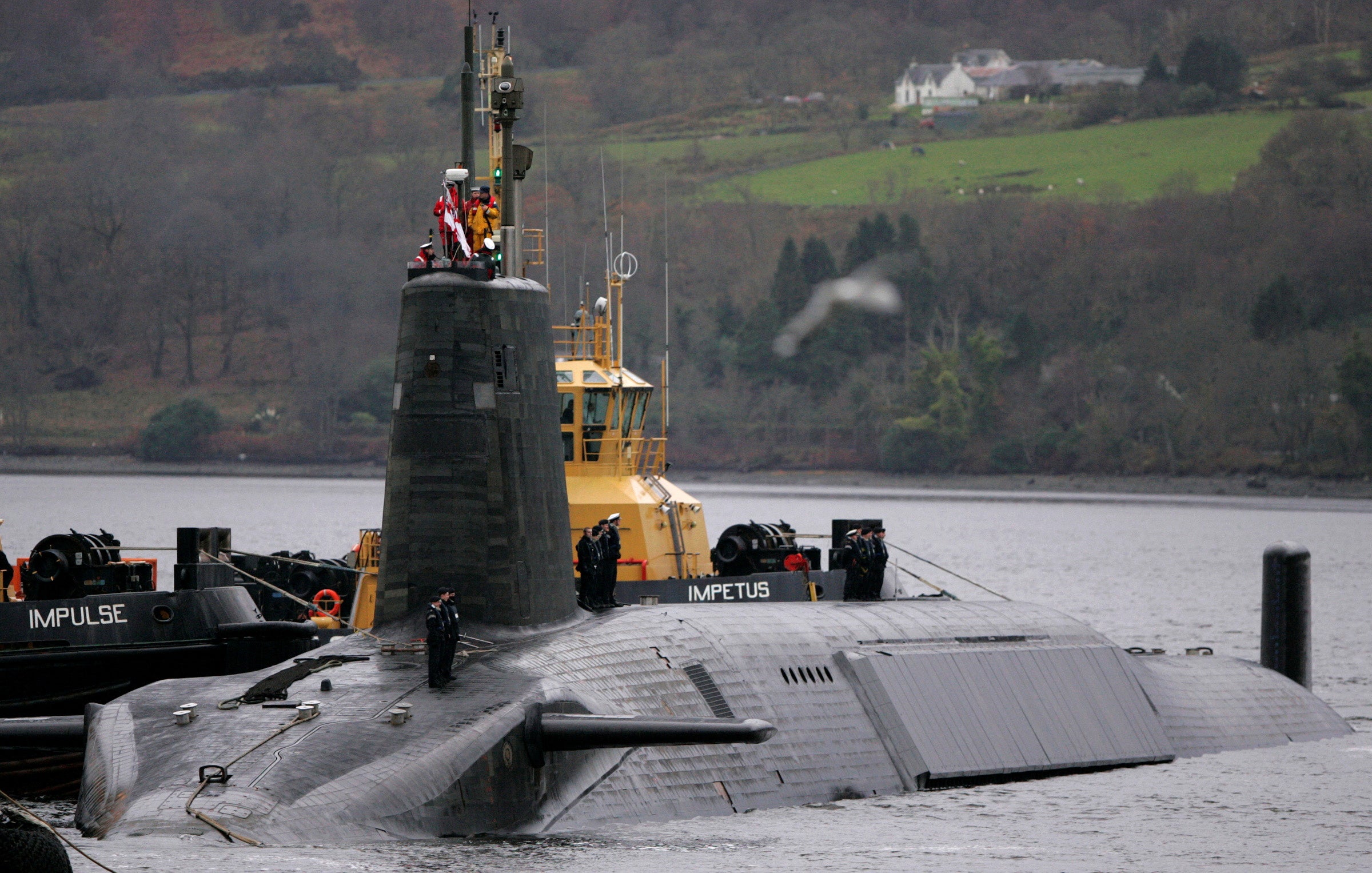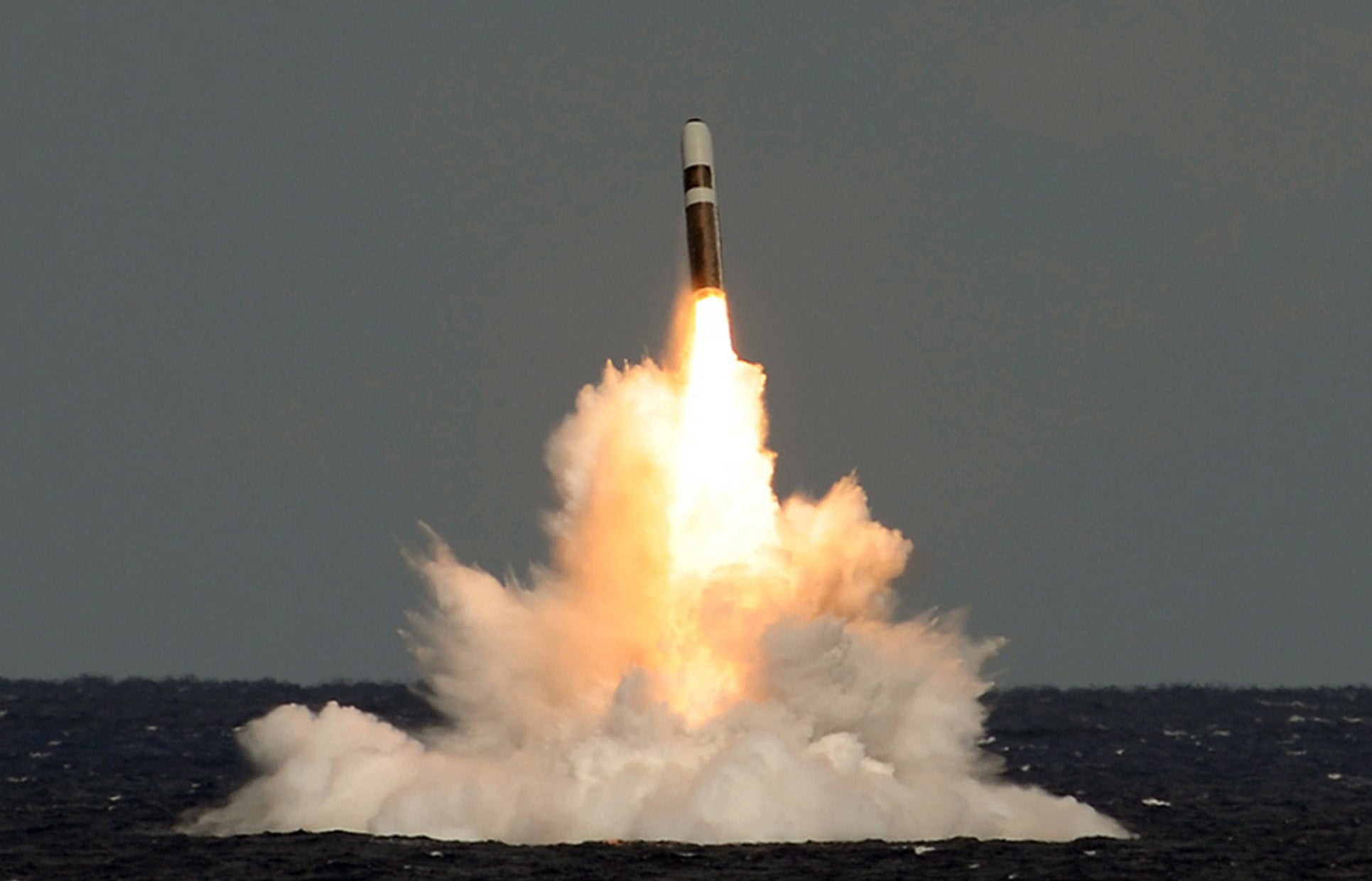Trident: The ins and outs of Britain’s nuclear deterrent with a history of malfunction
The most recent missile tested by HMS Vanguard is reported to have misfired and landed back in the ocean

The UK has tested Trident missiles 12 times since the weapons entered service in 1994, with each missile costing £17 million.
The most recent missile tested by HMS Vanguard on January 30 is reported to have misfired and landed back in the ocean, just metres away from the submarine with Defence Secretary Grant Shapps and First Sea Lord Admiral Sir Ben Kay onboard.
Downing Street was previously accused of covering up a reported malfunction in a Trident missile launched from HMS Vengeance off the coast of Florida in June 2016.
The missile is said to have veered off course towards the US before automatically self-destructing.
What is Trident?
Trident refers to the UK’s nuclear deterrent, which consists of four Vanguard-class nuclear submarines that first went on patrol in 1994, with one of the vessels continually at sea.
At any time since 1969, one Royal Navy submarine has been on patrol, another resting after returning from duty, one preparing to be sent out and one under maintenance.
The decision to replace the original Polaris missile system with Trident was taken by Margaret Thatcher in 1980, and debate over the next update to Britain’s continuous at sea deterrence (CASD) has been fraught.

Parliament approved the replacement of submarines in 2007 but only approved their construction in 2016, with the first replacement submarine expected to enter service in the early 2030s.
What is Trident capable of?
The Vanguard-class submarine, measuring 150 metres in length and 15,900 tonnes (15,900,000kg) in displacement, travels at more than 25 knots at depths in excess of 250 metres, according to the Royal Navy.
Powered by a Rolls-Royce PWR 2 nuclear reactor that converts water into steam to drive the engines and generate electricity, the submarine’s range is only limited by the amount of food stockpiled for its 132 crew members.
HMS Vanguard, HMS Vengeance, HMS Victorious, and HMS Vigilant can each carry up to 16 American-built Trident II D5 submarine-launched ballistic missiles (SLBM), each capable of delivering 12 independently targeted nuclear warheads, according to the House of Commons Library.
This means each vessel is technically capable of carrying 192 warheads, individually possessing the destructive power of eight Hiroshimas, but successive UK governments have limited the submarines to deploying with eight operational missiles and no more than 40 nuclear warheads.
A Trident missile can be fired at targets up to 4,000 miles away and can travel at more than 13,000 miles an hour, according to the Royal Navy.
The missiles are 13 metres long, weigh 130,000lb (58,500kg) and are ejected from the submarine by high-pressure gas before igniting as they reach the surface of the water.
How would Trident be used?
The launch of nuclear weapons can only be authorised by the Prime Minister, at which point the coded order would be sent down a command chain to the submarine.
Each submarine also holds a letter of last resort with instructions from the Prime Minister, to be read in the event of a catastrophic attack on Westminster.
On the appointment of a new Prime Minister, the previous letters must be destroyed unopened.

To fire the missiles there is no red button, but rather a trigger fashioned after the handgrip on a Colt “Peacemaker” pistol.
Where is Trident based?
HM Naval Base Clyde in Scotland, commonly known as Faslane, has been home to the UK’s submarine service since the 1960s.
The Royal Naval Armaments Depot at Coulport on Loch Long, eight miles from Faslane, is responsible for the storage, processing, maintenance and armament of the Trident missile system.
Submarine construction takes place at the BAE Systems shipyard in Barrow-in-Furness, while the nuclear propulsion systems are manufactured by Rolls-Royce in Derby. Babcock International maintains in-service submarines at the naval bases in Faslane and Plymouth.
Why do we have Trident?
Trident exists to deter a nuclear attack on the UK, for it preserves the potential for a retaliatory strike on an aggressor should Britain’s domestic defence capabilities be destroyed.
Where nations refrain from initiating a nuclear strike knowing it would invariably cause their own annihilation, this concept is referred to as mutually assured destruction (MAD).
The UK is one of nine countries known to have nuclear weapons, also including the US, Russia, France, China, India, Pakistan, Israel and North Korea.
How much does Trident cost the UK?
Total acquisition expenditure on the Trident programme in the 1980s was £12.52 billion, which equates to approximately £21 billion in 2022/23 prices, according to figures from the House of Commons Library.
Annual in-service costs of the UK’s nuclear deterrence are currently estimated at around 6% of the defence budget, which is forecast to be £3 billion for 2023-24.
Between £31 billion and £41 billion has been earmarked for replacing the Vanguard-class submarines with the new Dreadnought-class.
Why is Trident contentious?
Campaigners and politicians have raised concerns over the cost of Trident during a cost-of-living crisis, with the Campaign for Nuclear Disarmament (CND) claiming the cost of maintaining and replacing the Trident system over its lifespan could reach £205 billion.
The Scottish National Party has been a long-standing opponent of Trident, branding the programme “immoral, ineffective and expensive”.
Campaigners have argued that the rise of underwater drones hampers the second-strike reasoning for Trident and funds would be better spent on weapons for conventional warfare such as those needed in Ukraine.
The UK’s nuclear deterrent has also been criticised on ethical grounds by figures such as Jeremy Corbyn, who as Labour leader said he would refuse to press the nuclear button.
Instead, campaigners have called on Britain to set an example by promulgating unilateral nuclear disarmament and pointed to countries such as Canada, Australia and Spain which seem to cope without nuclear weapons.
Bookmark popover
Removed from bookmarks